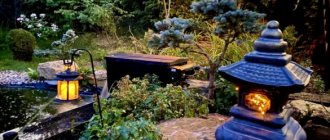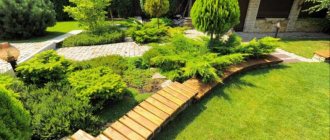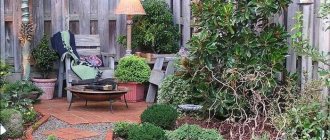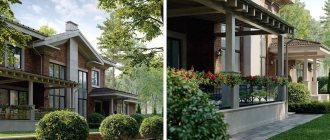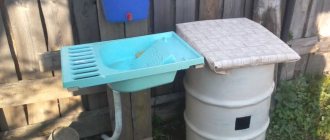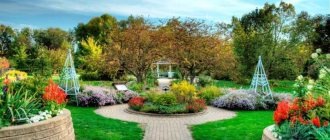Review author: Terrari School of Design
How to place outbuildings, fruit trees, a flower garden and a vegetable garden on 6 acres of land along with a house is not an easy, but doable task. A competent layout of a small area will help to implement these plans.
Thoughtful landscaping of the territory will hide imperfections and turn a modest space into a beautiful garden with cozy corners for relaxation, where everything is harmonious.
Site design
Sketching a plan is the first step to arranging the territory. At this stage, it matters whether it is an empty plot or an already inhabited dacha. In the first case, design principles are taken into account.
Allocate 10% of the land area for buildings along with the house, leave 75% for the vegetable garden and garden, and use the remaining 15% for flower beds, ponds, areas for games and recreation.
The plan takes into account every little detail, how to position it advantageously:
- Buildings along with the house.
- Garden paths.
- Water supply with sewerage.
- Landscape design elements for a small area.
- Furniture for outdoor recreation: rocking chairs, tables with benches, homemade sofas, benches, swings.
At a lived-in dacha, the distances between existing buildings are measured. Based on the results, a preliminary plan is drawn up, and then adjustments begin. By comparing dreams with reality, changes are made: what to rebuild, remodel or move to another location.
Large plants near the house
You can also plant large shrubs and trees near the house: if you place most of them near the fence, this will create a feeling of enclosed space, and you will also deprive yourself of sunlight.
Plant plants from large to small - let the composition gradually fade away. The center of the garden can be left open to create a feeling of spaciousness.
Landscape Design Rules
When planning the development of the territory, they are guided by the principle of zoning. But at the same time they rely on their preferences.
They also adhere to rules that allow you to profitably use the space of small or narrow areas:
- The buildings are distributed throughout the territory, interspersed with green spaces. Outbuildings are placed away from view, masked by vertical landscaping.
- A residential building and a garage are placed on the same foundation, facing the street next to the fence. Such economical construction will allow us to obtain additional square meters of land for planting.
- Gazebos with garden furniture for relaxation are placed in a part of the site remote from the noisy street.
- Garden swings, sandboxes, tables with benches for children are built in front of the windows of the house. In a place where there is sun and shade.
The landscape design of a small garden and the area in front of the house is done in the same style. Before purchasing or planting fruit trees and exotic plants, determine the type of soil and groundwater level in the area. This action will help exclude those types of flora that will not take root in such conditions.
Minimalism
Do not overdo it with garden decorations - pergolas, arches, figurines and homemade decor. Simplicity is the basic principle of designing a small garden, and this applies to both small architectural forms and plants. Choose one or two types of trees, two or three types of shrubs, three or four types of flowers.
If asceticism does not suit you, try to plant plants of similar shades: a riot of color will not increase the space.
Landscape design for a small plot
The second step to developing the territory is to implement your plan. The modern design of a small plot involves a visual expansion of space using the following techniques:
- Construction of lightweight structures.
- Hiding bulky buildings and fences with green spaces.
- Refusal of straight paths and geometric shapes.
- Creation of multi-level platforms: alpine slides, rock gardens, raised flower beds, terraces.
- Construction of decorative vertical elements: trellises, screens, arches, hedges.
Planning rules
To prevent this from happening, designers recommend using a few simple rules. These include:
- Placing all buildings at some distance from each other. Structures should not be massive or appear heavy. Hedges, climbing plants or picturesque shrubs will help to avoid this effect.
- Lack of a large solid fence. It is better to use transparent structures, past which the eye can glide freely.
- The absence of overly tall and spreading trees that will visually reduce the area.
- Using a single design style for all areas of the site.
- Use of simple forms and soft transitions between zones.
- The absence of sharp corners where they can be replaced with smooth lines.
- The functionality of any zone and the use of every free centimeter of land and above-ground space, for example, the use of hanging flower beds, trellises, fences, arches.
Masking the fence
A blank fence draws attention to the boundaries of the site. Next to such a bulky structure, other elements seem smaller, which causes a feeling of crampedness. The shortcoming is eliminated by replacing the fence with a picket fence, mesh or lattice type structure.
Additional plantings along the new fence will create the impression of a continuation of the garden and will close the area from prying eyes:
- Planted in groups: low trees - fir, yew, shrubs and coniferous species - juniper, thuja. They make up multi-tiered compositions from different species, complementing the plantings with herbaceous flowering perennials.
- Climbing plants grow along the fence - hops, wild grapes, clematis. Low-growing trees with a spherical crown shape are planted nearby.
- A trellis fence is formed, for example, from branches of yellow acacia or willow.
Fence on a small area
The higher and more massive the fence is, the more unnecessary attention it will attract. A small space enclosed by large sheets of corrugated sheets also has a negative effect on the psyche, making owners and guests feel like they are in a trap or box.
For small areas it is better to use lighter structures. They can be a transparent chain-link mesh, a picket fence that has been tested by time and generations of gardeners, or 2D fences made of metal rods.
If you want to protect yourself from curious neighbors or passers-by, plant ornamental bushes, trees or climbing plants, which will soon close the area from prying eyes.
If the area is already surrounded by a massive fence (for example, from the neighbors), it is also camouflaged with plants. The most commonly used are wild grapes, ivy, climbing roses, and lemongrass.
Paths and garden decor
The winding paths in the photo of the design of a small plot illustrate the best solution for decorating the territory.
Narrow, winding lines distract from boundaries and create the illusion of space rather than cramped space. This impression is enhanced by garden decor placed along the paths: flowerpots with flowers, figurines of animals and birds, Japanese lanterns or mini fountains.
A bold idea for garden paths: logs cut from logs are buried in the ground, and the voids are filled with sand.
Order
The problem with many areas is clutter. Piles of bricks, old boards, as well as branches and rusty garden tools do not decorate the garden, but make it even smaller. To avoid the feeling of cramping, all unnecessary trash must be taken to a landfill, and bushes, lawns and trees must be trimmed.
A well-kept garden seems spacious, but an overgrown one seems small and unattractive.
Yard in front of the house
When designing the area in front of the house, implement the following ideas at your own discretion:
- Lawn with family tree in the center. The perimeter is laid out with pebbles or tiles.
- Herbs or medicinal plants on a raised bed in front of the windows.
- Compositions from low varieties of coniferous bushes.
- Decorative vegetable garden in a flower garden. For planting, use sweet peppers, carrots with tomatoes and other vegetables, planting them together.
- Along the wall of the house: borders, ridges, arabesques, rock garden.
- Mini ponds in flowerpots with fountains, decorated with plants and figurines.
The yard with a lawn in front of the house will become beautiful and functional, with original wooden garden furniture. One such option is a chaise longue, on which you can relax while sitting, and lean back to lie or sunbathe.
Herb garden
Rosemary, mint, lavender, thyme, basil - growing herbs does not require special preparation or a separate area; a couple of square meters is enough for them. Aromatic plants love the sun - find a convenient place for them, create a high bed for planting in the ground, or simply group pots and containers with herbs at one point. Dark green sage, curly parsley, purple basil leaves can look very elegant next to each other.
Spicy plants contain essential oils - this, of course, gives them a unique aroma and makes them very valuable in the kitchen. But on the root, such herbs can smell too strong - so, contrary to fashion, do not place boxes with herbs on the eaves under the windows, on the veranda or on the blind area around the house.
If you like mint or lemon balm, plant them separately from other herbs : they smell stronger than other plants and “spread” across the beds, interfering with neighboring plants.
Trees and shrubs
Ornamental crops reach a height of 2 to 4–5 meters. The weeping shape allows you to create garden figures, for example, a mushroom with a wide cap, a green hut with an open entrance:
- Yellow acacia.
- Birch Junge.
- Goat willow.
- Rough elm.
From fruit, berry and flowering crops, the following are grown in a small area:
- Trees – cherry, lemon, dogwood, plum.
- Shrubs – boxwood, lavender, camellia, viburnum, rose hips.
Juniper for a small garden
Where thuja grows, as a rule, they cannot do without juniper bushes. It perfectly complements the composition, filling the lower level (if you choose low-growing forms). Junipers vary in shape, height and color. Their crown can be: creeping, spherical, weeping, pyramidal and cone-shaped.
The smallest representatives of junipers grow up to a maximum of 1 m, and the largest tree-like ones - up to 12 m. On average, decorative forms reach a height of no more than 4 m. For small areas it is better to choose the shortest growing junipers. Bushy forms will represent the second and third tiers, and tree-like forms will represent the first. The most common combination is juniper bushes next to columnar or pyramidal thuja.
In addition to being decorative, this plant has medicinal properties - breathing its recognizable aroma is good for health. It purifies the air by producing phytoncides. Inhaling this scent can calm your nerves and even normalize your sleep. Once upon a time, in ancient times, juniper smoke was even used to fumigate homes, protecting them during epidemics.
Juniper, like thuja, is an evergreen plant. By combining it with other conifers, you can create timeless compositions that will delight you all year round. For example, a rock garden that does not require a lot of time and plants. For small areas, different varieties of junipers such as Cossack, Virginia, Siberian, common, Chinese, rocky and scaly are suitable. They are distinguished by excellent winter hardiness and decorative properties.
In general, junipers are unpretentious plants that can grow in different lighting conditions and in any soil. But on fertile lands they feel and look better (which has a positive effect on their decorative properties). On loamy soils, before planting juniper, you need to make drainage from small stones or broken red bricks - this will avoid stagnation of water. The latter is especially true for places where groundwater passes close to the surface of the earth.
Vertical gardening
Landscaping with plant compositions on a vertical support saves area. This is how the façade of a house, a fence, and garden buildings are decorated. Examples:
- Trellis with flowers, leafy vegetables, Provençal herbs. Lattice structures in the form of straight and diagonal shapes have a beautiful decorative appearance.
- A ladder and a stepladder are like a flower garden in landscape design. Miniature birdhouses and garden figurines are placed next to potted plants.
- Phytowalls are flower beds on the wall, where plants, berries, herbs, and greens are placed in special containers.
- Vertical garden in boxes, pots or buckets on the facade of the house, fence, shelves.
- Pergolas for grapes, arches with boxes for growing strawberries.
Helpful Tips:
Flat areas are much more advantageous than winding areas with slopes.
Choose an area with rectangular shapes.
Loamy and sandy loam lands are more suitable for construction and a good harvest.
Give preference to deep groundwater.
Focus on the cardinal directions.
All buildings must be built taking into account fire safety rules and building codes.
Multi-tiered flower beds
Raised flower beds, as a successful landscaping technique for a small area, perform two tasks:
- They create the illusion of space flowing.
- Hide changes in terrain.
They build multi-tiered flower beds from stones, bricks or scrap materials. For example, ceramic pots or tires of different sizes are placed on top of each other. An old chest of drawers is used for planting vegetables, Provençal herbs, berry bushes, and flowers in pulled out boxes with soil. Other options:
- Flower beds are made from stones or bricks in the shape of a spiral.
- Wooden boxes and flowerpots with flowers or vegetables are placed on the steps of the main staircase.
Garden, decorative all year round
A low-maintenance garden is a garden that maintains its decorative appearance and plant health with a minimum number of agrotechnical measures. Such a garden requires a minimum of effort: all the land in it is occupied by dense plantings or covered with beautiful mulch - there is simply nowhere for weeds to squeeze through; The plants in it are not just hardy - they are indestructible; watering is automated.
This is what one of the most popular low-maintenance gardens on our portal looks like now, created by Alina (nickname on FORUMHOUSE Leka77).
But this is how he was at the very beginning of his life.
Alina initially conceived a garden in a landscape style that would remain decorative throughout the year without much effort on her part.
Leka77 Member of FORUMHOUSE
This is a garden that is friendly to small children and their “big” pranks, to pets and to the active pastime of adults. I try to use plants from our strip as much as possible. I took English gardens with their elegant and carefully thought-out neglect as my ideal and prototype.
Another FORUMHOUSE member with the nickname mila_pav was planting a garden so that over time the hassle with it would not increase, but decrease.
mila_pavFORUMHOUSE member
To do this, you need to plant stable and hardy plants that do not require shelter for the winter, frequent pruning, etc. Plant them so that they close together as they grow and do not give weeds a chance.
Garden vintage
The most beautiful site is created with your own hands. The garden is enlivened by homemade wooden furniture and vintage decor - outdated things that are used in dacha farming.
Old wheelbarrows, saucepans, buckets, teapots, carts are used to create flower beds. They are filled with herbs, flowering and ornamental plants, and vegetables.
Using shell beds, baskets create elegant flower beds. Everything will come in handy on the site, even old galoshes that are used for vertical gardening. Vintage items, structures made from natural materials, benches, benches, folding chairs with your own hands make every corner of the garden much more comfortable and relaxation more enjoyable.
Mirror
Use a technique that is often found in interiors - enlarge a small garden with a reflective surface. A mirror - even an old one, covered with patina and small scratches - will fit perfectly into the atmosphere of the garden, adding a little magic. Hang the mirror canvas on a fence, the facade of a house or a country house.
Let the mirror reflect the most picturesque corners of the garden - flower beds, a fountain, fruit trees.
Water features
In a small area, water structures are modest in size. They are built in shaded areas and away from trees and bushes. The sun can cause the water to bloom, and the roots will eventually destroy the tank.
- Pond made from scrap materials. Tires, bathtubs, basins, buckets are suitable. If you build such a pond on a slope, you can make a stream emanating from it, flowing into the garden or garden.
- The landscape waterfall is combined with an alpine slide.
- Decorative fountain. Traditional structures are used to create them: sheds, mills, and utensils.
- A dry stream of stones with a bridge over it. Masks uneven terrain and serves as decoration for the area in front of the house.
Lighting
The more light, the wider the space appears. Take advantage of this! If during the day a fence with gaps and low trees help you, then in the evening lanterns and garlands will come into their own. Buy solar-powered street lights that don't require electricity.
Hang garlands along the gazebo or trees and decorate garden paths with lanterns on supports to expand the space in the evening and create a magical atmosphere. During the day, such details will become an additional decoration of the landscape.
A small garden, like any small space, requires thoughtfulness. Listen to our advice if the local area seems too cramped: even a small area can look solid if you apply knowledge and effort.
In the backyard
An interesting idea is a multi-level platform. On the upper tier they place a picnic table under a canopy, sofas with pillows, and hang pots with flowers. Below is a pond with a fountain or waterfall and vegetation. Such a corner is fenced off with hedges.
For low fences, improvised materials are used, for example, headboards, tiered flower beds, racks with flowerpots.
Potted garden on the terrace
Many townhouse owners are adding covered terraces with year-round flooring to their properties. You can decorate such a terrace with a pergola or a trellis with climbing plants - vertical gardening will make the garden mysterious. You can arrange a flower border around the perimeter.
But the easiest way would be to organize a potted garden: install pots with plants wintering in the house at different heights (use stands and shelves).
Now on the market there are special flower pots with an automatic watering system - your indoor flowers will feel very comfortable all summer long!
In the shade of the trees
A simple way to organize cozy places to relax is to place wooden sun loungers, hang a hammock chair, and make benches from stumps and logs. In the gazebo, install homemade sofas with pillows, poufs made from tires, and a coffee table. An old trellis will also come in handy at the dacha as an element for creating the illusion of perspective.
Landscape design changes a small area beyond recognition for the better. And fashionable techniques minimize gardening and vegetable garden care.
After arrangement, the area seems spacious and cozy with garden furniture and quiet sitting areas. When fatigue sets in after a week of work in the city, then you realize that the modest size of the dacha is an advantage.
8. Garden collection
If you are a collector at heart, then your option for decorating a small area is a thematic collection of various plants, presented in one or two copies. You can collect roses, or, for example, cereals. If you have a damp area or not enough sunlight, collect moisture-loving or shade-tolerant plants from different parts of the world.
Coniferous trees, again, are in great fashion - but not the ordinary ones that we talked about above, but subminiature varieties: the so-called nanoconiferous trees, which in adulthood barely reach the size of a tennis ball.
Caring for them is quite a responsible task. The most important point is regular cleaning of the insides of the crown from the remains of dead needles: kids are simply not able to cope with this task themselves! But you will have something to surprise your friends and neighbors.
Photo of small plot design
Annuals for a small garden
The group of annuals is very large. This includes a variety of annual flowers that can be used to fill mixborders and flowerpots or pots, highlight paths and decorate various compositions. Annuals have always been, are and will be. They are an integral part of most gardens, including the smallest ones. There is no point in listing such plants here or giving any examples. You can easily find a wide range of these colors in various online and offline stores. When choosing annuals, consider color compatibility, layering, flowering time and requirements for external conditions. It’s good if you can choose flowers that will allow some to bloom when others have already faded. This is one of the principles of successful creation of flower beds and mixborders.
Brightly flowering annuals in a small garden can be placed in flowerpots or pots (including hanging ones). Be sure to plant them on your site - then the summer season will give you maximum impressions. In order to feel happy, all you need is a small garden and a great desire to create beauty with your own hands. Are you ready to make it a reality?
Join our Facebook group
Some tricks
It should be said about the versatility of the art of landscape design. Landscaping is an important part of the complex process. How to properly plant flowers and beds:
- With the right selection of color palettes, a small area will look visually larger. For these purposes, it is worth using white or yellow flowers. Cold tones should be avoided, especially in border areas.
- There is no need to oversaturate the composition with different colors. A combination of several shades will be more harmonious than a cluster of different shades in a chaotic manner.
- It should be borne in mind that many plants prefer the shady side.
- You should not make the flower beds symmetrical, as this will limit the visible spaces of a small area.
- Vertical landscaping looks quite impressive.
- To make a bright accent, you can create an original flowerbed using available materials. For example, a nicely painted bicycle or an old cart will work just fine.
There is no need to build continuous beds. It is better to replace them with unusual and elevated shapes. These can be geometric shapes with spices or vegetables.
Beautifully landscaped area in front of the house
The area that will catch your eye as you leave the house deserves the most special treatment. Here you need to carefully select all the elements, taking into account what material they are made of and what color palette they have. You can build a small hedge of living plants or a pond. There are a number of principles that should be followed :
- When planting flowers near a building, you should select them in the same shades as the wall decoration.
- For greater effect, you need to plant plants with large leaves.
- To maintain the attractiveness of the design during the cold season, it is recommended to use evergreen shrubs.
- Bushes should be trimmed into shapes, this will make the look more elegant.
- Figurines or statues will add a special feature to the area.
There are different approaches to designing a garden plot. The main thing is to use recommendations that are suitable for a particular situation, adding your own creative tricks to them to achieve a unique picture.
Choosing the right plants for small gardens
Clever use of plants can transform even the smallest garden into a beautiful and harmonious space. A key aspect of planting in tiny gardens will be layering and grouping low, medium and taller species together.
Crab apple trees are an excellent choice for a small garden. They have beautiful flowers in the spring, lovely green foliage in the summer, colorful fruit and golden leaves in the fall.
crab apple tree
The graceful Japanese maple with delicate leaves of different colors and the same stems will allow you to enjoy the beauty.
Japanese maple stands out well on the site
A carefree oakleaf hydrangea shrub with serrated leaves will brighten up your garden. In autumn they take on bright shades of scarlet, purple and orange. Elegant white flower panicles bloom in summer. They fade to shades of pink and soft beige. The attractive, cinnamon-colored, flaky bark is most noticeable in winter. Oak hydrangeas perform best in sunny locations and require less water than other plant types.
English boxwood serves many important functions. It will divide the garden into sections, serve as a border for paths, or can grow as a free-standing plant in containers.
English boxwood
An excellent addition to any small garden is the dwarf Hinoki Cypress. It is a popular evergreen with a captivating layered texture and dark green foliage.
Dwarf Cypress Hinoki
One way to make the most of a small space is to grow climbing plants. Clematis are revered for their range of flower shapes and colors. Grow several types of this plant together and you will beautify your garden all season long.
Perennials are ideal for small gardens. They have attractive foliage and a long flowering period.
Small gardens are the perfect space to try new color and texture combinations. Combine numerous perennials with purple and bright yellow flowers. You will get a unique corner of nature.
If you're looking for a carpet of foliage, you can grow thyme or phlox.
One of the most romantic aspects of any garden is its scent. When planning your plantings, try adding lavender or roses to make it smell fragrant.
A varied mix of trees, shrubs, perennials and climbers will be the key to creating a garden that will please the eye.


